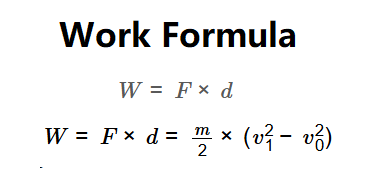1. What is a Work Calculator?
Definition: This calculator determines the work done on an object, either by applying a force over a distance or by changing its velocity.
Purpose: It is used in physics to calculate the energy transferred to an object when a force is applied.
2. How Does the Calculator Work?
The calculator supports two methods to calculate work:
1. Basic Work Formula:
\[
W = F \times d
\]
2. Work from Velocity Change:
- Force: \( F = m \times a = m \times \frac{v_1 - v_0}{t} \)
- Distance: \( d = t \times \frac{v_0 + v_1}{2} \)
- Work: \( W = F \times d = \frac{m}{2} \times (v_1^2 - v_0^2) \)
Where:
- \( W \): Work done (J, kJ, MJ, Wh, kWh, ft-lb, kcal)
- \( F \): Force applied to the object (N, kN, MN, GN, TN)
- \( d \): Distance the object moved (mm, cm, m, km, in, ft, yd, mi)
- \( m \): Mass of the object (kg)
- \( v_0 \): Initial velocity (m/s)
- \( v_1 \): Final velocity (m/s)
- \( t \): Time (s)
Unit Conversions:
- Force (F): N, kN (1 kN = 1000 N), MN (1 MN = 1000000 N), GN (1 GN = 1000000000 N), TN (1 TN = 1000000000000 N)
- Distance (d): mm (1 mm = 0.001 m), cm (1 cm = 0.01 m), m, km (1 km = 1000 m), in (1 in = 0.0254 m), ft (1 ft = 0.3048 m), yd (1 yd = 0.9144 m), mi (1 mi = 1609.344 m)
- Mass (m): kg
- Velocity (v₀, v₁): m/s
- Time (t): s
- Work (W): J, kJ (1 J = 0.001 kJ), MJ (1 J = 0.000001 MJ), Wh (1 J = 1/3600 Wh), kWh (1 J = 1/3600000 kWh), ft-lb (1 J = 0.73756214927727 ft-lb), kcal (1 J = 1/4184 kcal)
Steps:
- Select the calculation mode (Basic Work Formula or Work from Velocity Change).
- Enter the required values (force and distance, or mass, initial velocity, final velocity, and time) and select their units.
- Convert all inputs to base units (N, m, kg, m/s, s) for calculation.
- Calculate the work using the selected formula.
- Convert the result to the selected energy unit and display.
3. Importance of Work Calculation
Calculating work is crucial for:
- Physics Education: Understanding the concept of energy transfer.
- Engineering: Designing systems that involve mechanical work.
- Mechanics: Analyzing the motion of objects under applied forces.
4. Using the Calculator
Examples:
- Example 1 (Basic Work Formula): For \( F = 10 \, \text{N} \), \( d = 5 \, \text{m} \):
- Work: \( W = 10 \times 5 = 50.000 \, \text{J} \)
- In kJ: \( W = 50 \times 0.001 = 0.050 \, \text{kJ} \)
- Example 2 (Basic Work Formula with Units): For \( F = 1 \, \text{kN} \), \( d = 500 \, \text{cm} \):
- Convert: \( F = 1 \times 1000 = 1000 \, \text{N} \), \( d = 500 \times 0.01 = 5 \, \text{m} \)
- Work: \( W = 1000 \times 5 = 5000.000 \, \text{J} \)
- In ft-lb: \( W = 5000 \times 0.73756214927727 = 3687.811 \, \text{ft-lb} \)
- Example 3 (Work from Velocity Change): For \( m = 2 \, \text{kg} \), \( v_0 = 0 \, \text{m/s} \), \( v_1 = 5 \, \text{m/s} \), \( t = 2 \, \text{s} \):
- Work: \( W = \frac{2}{2} \times (5^2 - 0^2) = 1 \times 25 = 25.000 \, \text{J} \)
- In kcal: \( W = 25 \times (1/4184) = 0.006 \, \text{kcal} \)
5. Frequently Asked Questions (FAQ)
Q: What is work in physics?
A: Work is the energy transferred to an object when a force is applied over a distance, calculated as \( W = F \times d \).
Q: Can work be negative?
A: Yes, work can be negative if the force and displacement are in opposite directions, but this calculator assumes positive inputs for simplicity.
Q: How does velocity change relate to work?
A: When an object changes velocity, the work done can be calculated using the change in kinetic energy, as shown in the formula \( W = \frac{m}{2} \times (v_1^2 - v_0^2) \).
 Home
Home
 Back
Back
